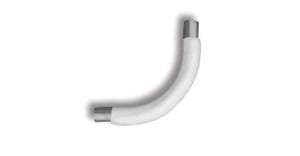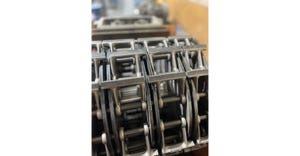Things to consider when selecting and configuring a tubular drag conveyor for his or her facility
October 18, 2022
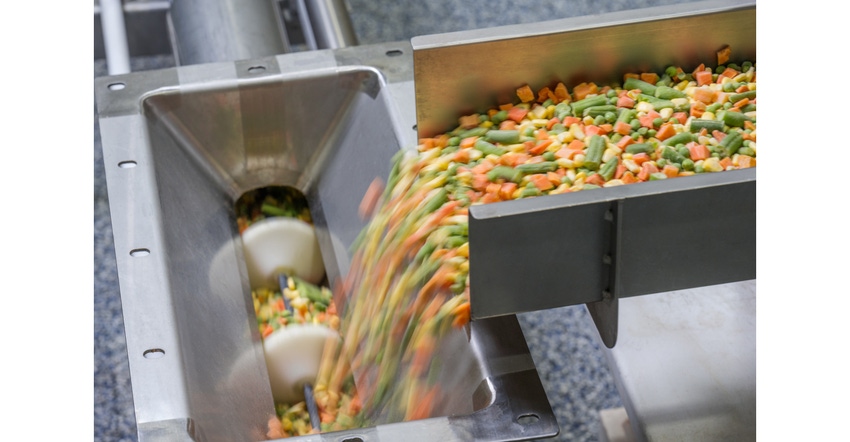
Bob Owen, director of product performance, Cablevey Conveyors
Industrial processing companies who are replacing a conveyor line or adding a line extension in their operating facilities face a host of design considerations. The goal is to move products in a safe, effective, and efficient manner while minimizing operating and maintenance costs and sparing labor.
A tubular drag conveyor is among multiple conveyor technologies or types. Tubular-drag style disc and cable conveyors offer gentle conveyance of friable materials to preserve product integrity, avoid ingredient sifting, and effectively contain dust. The enclosed nature of the technology contributes to plant hygiene while simultaneously preventing foreign contaminants from entering the product stream.
Proper system design can provide a materials handling solution that will supply years of reliable service. This article will discuss the various considerations for a plant operator when selecting and configuring a tubular drag conveyor for his or her facility.
Questions to Ask About the Product or Material Conveyed
One of the first considerations focuses on the product to be conveyed. Typical questions about the product can include:
What material is going to be transported?
If it is a blend or mix, are there particle size differentials?
What are the minimum and maximum bulk densities?
Are some of the materials more delicate than others or more friable?
Is the material abrasive, and if so, to what degree?
What is the product moisture level?
Is combustibility a concern?
What is the product’s ambient temperature?
Has there been a problem with product degradation with current or previous systems?
Are there any current expansion plans (i.e. new SKU introductions or changes in product lines)
What is the desired volume or throughput?
Volume/Throughput
A range of tube diameters allows for the transport of different materials from powder to pet food, offering varying capacities depending on product bulk density. Typical options include:
* A 2-in.-diam tube conveyor was originally designed to move mash and grain mixes. Now, these commonly move chaff, cookie crumbs, seeds, and ground coffee. A typical maximum capacity transports up to 75 cu ft/hr (3,000 lb).
* A 4-in.-diam tube conveyor is more widely used. Typically these offers a maximum capacity of up to 525 cu ft/hr (21,000 lb).
* A 6-in.-diam tube series transports up to 1,240 cu ft/hr (@49,000 lb).
* An 8-in., high-volume cable conveyor typically offers a system capacity of up to 2,000 cu ft/hr (80,000 lb).
Product Integrity
While throughput and volume are important, so is profitability. A system that maintains product integrity or avoids product degradation reduces costly wasted product. The cable and tube conveyor technology design gently handles materials from inlets to discharges by holding those materials between the discs within the enclosed tube.
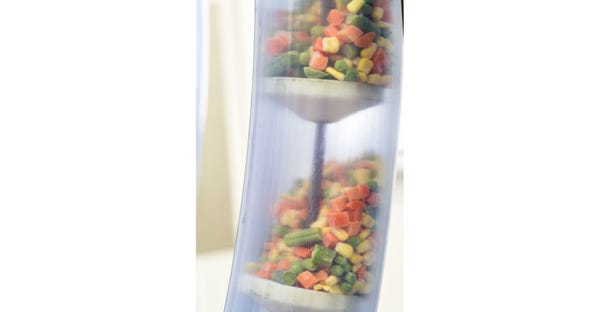
Sweeps navigate curves and directional changes to convey materials to the desired discharge station. However, the disc and cable conveyor design means materials are not blown or forced through the sweeps as with other types of conveyor technology. Friable materials are conveyed without battering, stress, or friction to keep breakage to a bare minimum. Depending on the price per pound of the basic ingredients or materials, even a quarter of a percent of product preservation can translate into thousands of dollars of savings per year.
Flexibility in Design Due to Modular Components
One thing to look for in a tubular-drag style conveying system is flexibility in design due to modular construction. The basic components can be assembled in myriad configurations to fit within the allotted space or plant footprint, including taking advantage of overhead space.
When the tubular conveying system is comprised of modular components, operators may find it easier to maintain, service, and clean the system. Components include the cables, discs, tubes in stainless or clear FDA-approved plastic for viewing purposes, drives, turnarounds, and sweeps.
Direction and Distance
Materials can travel horizontally or vertically, from multiple inlets to discharges. As for distance, materials may be conveyed up to 300 ft in a single system. However, distance is determined by the number of sweeps, required capacity, and the type of product being conveyed.
Sweeps are generally available for system configuration in 30-, 60-, or 90-degree angles. Often the design and layout require minimal modification to the existing facility.
Layout and Elevation
A cable and disc system offers a variety of potential configurations capable of operating on multiple planes, from feed silos to the production floor to a mezzanine level, with few limits on direction or height.
Sample layouts include inline, a loop, vertical transfer, or a combination or blend of horizontal-vertical-horizontal. Systems can take product from one building into another.
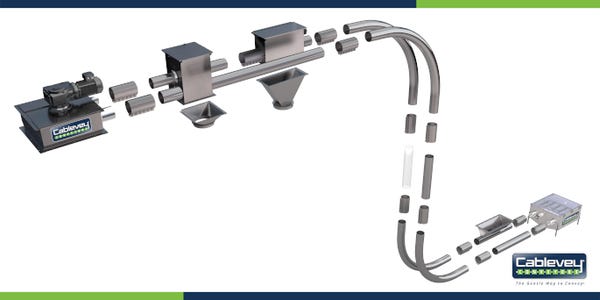
Footprint
Cablevey’s recent State of Conveying report revealed that 83% of companies operate six or more conveyor systems in their facilities. With multiple lines already operating within a finite amount of space, a new or replacement system that can be configured in multiple ways to fit within that space or footprint has heightened importance. Replacing a bucket elevator, for example, with a drag cable system, involves careful selection of sweeps and placement of the turnaround, not just for space concerns but also to facilitate cleaning and maintenance.
A cabled conveyor system can take advantage of overhead space as long as the operator can still access the system with a lift or via a mezzanine.
Feed/Discharge
Automated feed and discharge configurations allow for continual material processing and delivery. Select inlets based on the diameter of the system and the number, size, and type of inlets and discharges for single or blended product mixes.
Plant Sanitation and Cleanability
When selecting system components, an important consideration relies on the plant’s cleaning requirements and whether or not production must meet FDA regulations.
Does the plant rely on wet or dry cleaning? Are there regular washdowns? Does the system need to accommodate clean-in-place (CIP) routines? The answers to these questions play a role dictating material choices for the system and components, most often constructed of stainless steel or FDA-approved polymers.
An enclosed system drastically cuts down on dust for greater plant sanitation and safety, virtually eliminating the potential for foreign contaminants to enter the product stream.
In terms of cleaning the system itself, equipment manufacturers offer a variety of optional cleaning elements for a dry clean designed to meet a variety of swab-test standards. These cleaning elements can include brushes, air knives, and single-use sponges. Urethane clean-out discs are a replaceable option to help keep tubes free from dust, product fragments, or residue. Wet-wash conveyor systems are also available.
Supervised Installation
The installation is a critical last step in the design process. During a professional, supervised installation, the technician may recommend revisions to the layout or system movement.
These final adjustments can ensure the system will operate to its maximum potential while permitting easy cleaning and maintenance.
Energy Considerations
Conveying systems--sometimes called “energy hogs”--generally consume quite a bit of the energy used in a processing plant. This only increases the importance of an energy efficient conveyor in an era of rising energy costs and compliance to corporate sustainability pledges.
The design of a cable and disc conveying system features a compact drive unit that operates to its full potential while relying on a minimal amount of horsepower. This significantly cuts the energy expenditure of the system compared to alternative conveyor technologies. The smaller drive offers benefits such as:
* Dramatically less power use
* Quieter operations for a better work environment
* Lower energy usage cuts operating costs over the lifetime of the system
From energy costs to the type of material conveyed, the design considerations described in this article will help plant managers select the ideal tube drag disc and cable conveyor for their application.
Bob Owen is director of product performance, Cablevey Conveyors (Oskaloosa, IA). For more information, call 641-458-1185 or visit cablevey.com.
You May Also Like
